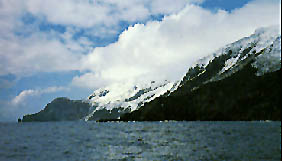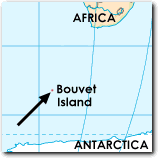Bouvet Island

The most remote spot on earth
|
|
 Landing on Bouvet Island is no mean feat â even the navigator who discovered it (and whose name it bears) was unable to do so.  |
Where Is It?
Bored with tropical retreats and looking for something a little more invigorating and brisk? Try the sub-Antarctic. Bouvet Island is located in an isolated expanse of the South Atlantic Ocean, 1,500 miles southwest of the Cape of Good Hope, and about 1,050 miles north of Queen Maud Land in Antarctica. The nearest island is Gough, 1,020 miles northwest, an uninhabited island belonging to the Tristan de Cunha islands. Who says it's the most remote island? The Guinness Book of World Records, for one. If you're still skeptical, pull out a map and decide for yourselfâhave you ever seen a more desolate, god-forsaken place?
What to Expect
This Norwegian island (Bouvetøya in Norwegian) is 23 square miles of black lava and glacial ice. It has an inactive volcano called Olaf Peak (2,560 ft) at its center. The island is often surrounded by several miles of frozen sea, and thick clouds of fog frequently cluster above itâsunshine is rare. Snowfalls are frequent, and temperatures seldom rise above freezing.
Bouvet was discovered on January 1, 1738, by French navigator Jean-Baptiste Bouvet de Lozier, but dense fog prevented him from landing on the island. He returned to France bitterly disappointed. Several other expeditions after Bouvet's also failed to land, and it wasn't until well into the next century before a human being actually stood on the islandâan American, Benjamin Morrel, became the first in 1822. Three years later, an English captain landed on the island and renamed it Liverpool. But on December 1, 1929, a Norwegian expedition claimed the island for once and for all, and changed the name back to Bouvet.
Not only is Bouvet utterly isolated from the rest of the world, but landing on it once you get there is next to impossible. John Clouseâ"No. 1 world traveler," according to Guinness (see Clipperton Island profile)âhas failed twice to reach Bouvet because of inclement weather: "I got 400 meters from there once, but had to turn back." One person who has made it to Bouvet is Delphine Cooper of South Bend, Indiana, who like Clouse, is a member of the Travelers' Century Club (initiation requires proof of having visited 100 or more countries and territories). Cooper chartered a boat to Bouvet, and after identifying a safe landing place, switched to a small rubber raft to make the final push to the shore. "I caught the weather just right," she reports. "It's not a beautiful island, but it's thrilling to know that I'm one of the few people that has ever set foot on it. What makes a place unique for me is the margin of difficulty to get there."
In 1989, a scientific expedition to Bouvet managed to solve the transportation problem: they enlisted a boat equipped with a small helicopter to assist in carrying people and equipment to the island. We recommend the helicopter option over Cooper's choice of a rubber boat.
Highlights
So it's cold, gloomy, out-of-the-way, and not much to look at. Consider the adventure you'd have trying to get there. And think of the privacy! Actually, we must confess that it's no longer as private as it used to be. The Norwegian Polar Institute is now conducting experiments having to do with the breeding habits of seal colonies on the island. The scientists are reportedly not fond of helicopters whirling about overhead, potentially inhibiting the seals. They have in fact banned all visitors during seal breeding season, which of course, just happens to coincide with the best time to visitâthe austral summerâwhen the miles of ice surrounding the island are not quite so intractable.
Bouvet has also become a coveted spot for ham radio enthusiasts, and is "near the top of the 'most wanted list'" of desirable places from which to send a transmissionâthere's even a Norwegian ham radio organization called Club Bouvet. Three expeditions thus far have connected Bouvet and the rest of the world by radio, and more are in the works.
Is there no terra incognita left anywhere?
Howland Island |
Introduction |







